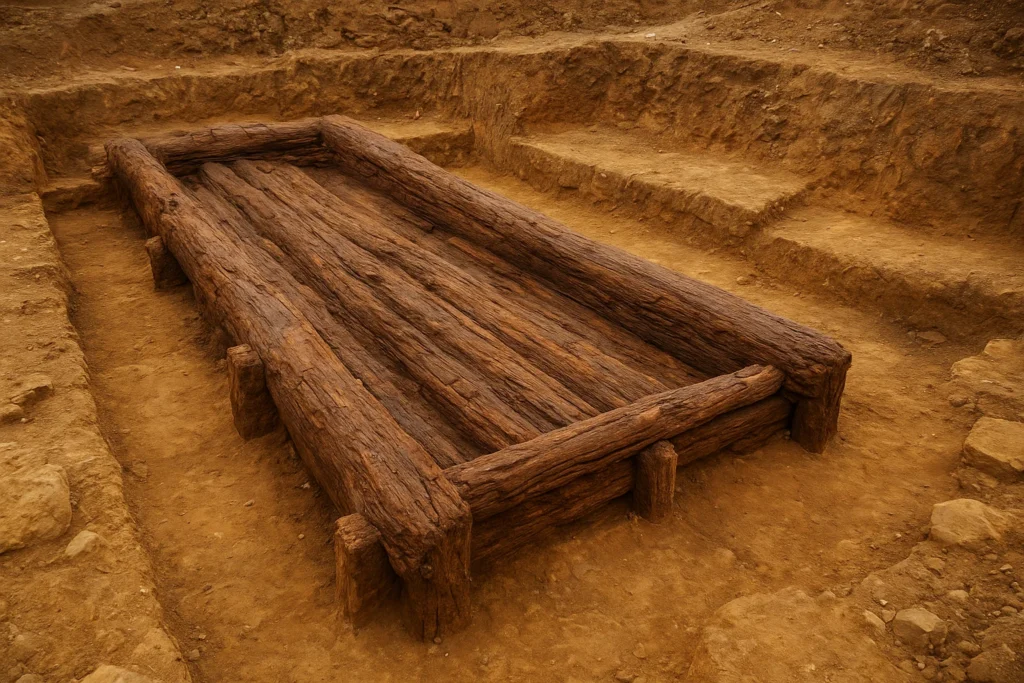Introduction: Rewriting the Story of Our Deep Past
For generations, the narrative of human origins has been built on a foundation of stone. The term “Stone Age” evokes images of nomadic hunter-gatherers, their lives defined by the flint axe and the spear point. Yet, this long-held perspective is being dramatically reshaped by a single, revolutionary discovery. On the banks of the Kalambo River in Zambia, archaeologists have unearthed a relic so profound that it forces us to rethink everything we thought we knew about our ancient ancestors. This is not just an archaeological find; it is a time capsule, a 476,000-year-old testament to a level of cognitive ability and technological sophistication we previously believed to be unique to modern humans. This wooden structure, meticulously crafted and interlocked, predates the appearance of Homo sapiens by nearly a third of a million years. It is a silent declaration that our predecessors were not merely surviving; they were engineers, builders, and innovators, shaping their world with purpose and foresight.
This is the story of the oldest wooden structure ever discovered, a discovery that fundamentally challenges the “primitive” label and opens a new chapter in the chronicle of human evolution.
A Stroke of Luck and Science: The Discovery at a Unique Site
The road to this groundbreaking find began not with a sudden breakthrough, but with a persistent hunch and a return to a site with a rich, if underexplored, history. Kalambo Falls, a breathtaking cascade dropping 235 meters, has long been a place of archaeological interest. It was first excavated in the 1950s by J. Desmond Clark, a pioneering British archaeologist who found evidence of early hominin occupation, including some fragile wooden artifacts. However, without the benefit of modern dating techniques, the true age and significance of these wooden pieces remained a frustrating mystery.
Decades later, a team led by Professor Larry Barham from the University of Liverpool returned to the site, equipped with cutting-edge technology and a new perspective. They were not just searching for more stone tools but were specifically targeting the waterlogged sediments that had preserved Clark’s earlier finds. As they meticulously dug, they unearthed something extraordinary: not isolated fragments, but two logs, deliberately shaped and fitted together. The top log, from a large-fruited bushwillow tree, had a meticulously carved U-shaped notch designed to fit perfectly over the lower log, forming a stable joint. This wasn’t a natural arrangement; it was the product of design and effort. The visible tool marks, a mosaic of scrapes, cuts, and chop patterns, were irrefutable proof of its intentional construction.
A Geological Miracle: The Key to Preservation
The very existence of this wooden structure is a scientific anomaly. Under normal conditions, wood decomposes in a matter of decades, let alone millennia. But the Kalambo Falls site is a geological anomaly. The fine silt and clay deposited by the river created a unique, waterlogged and oxygen-deprived environment. This natural encapsulation acted like a perfect time capsule, preventing the decay that would have been caused by bacteria and fungi. The structure was entombed, frozen in time, its delicate details—from the precise fit of the joint to the microscopic tool marks—preserved for nearly half a million years. This incredible preservation is what allows us to glimpse a part of human history we previously thought was lost forever.
The Builders: A Mystery of Ancient Minds
While the structure itself provides a wealth of information, the identity of its creators remains a captivating puzzle. No human remains were found in direct association with the logs, leaving scientists to speculate on the species of these ancient engineers. Several hominin species are known to have inhabited Africa during this period, each a possible candidate:
- Homo heidelbergensis: Considered by many to be the most likely builder, this species lived between 700,000 and 200,000 years ago. They were known for their use of fire and sophisticated tools, and their presence in Zambia makes them a strong contender. They represent a crucial evolutionary link, possibly being the common ancestor of both Neanderthals and modern humans.
- Homo erectus: The first hominin to spread beyond Africa, Homo erectus was an incredibly successful species known for its advanced tool-making and potential for complex behavior, including the use of language.
- Homo naledi: A more recently discovered species from South Africa, Homo naledi has shown surprisingly complex behaviors, though their precise timeline is still being studied.
Regardless of the specific species, the cognitive implications are profound. Building such a structure demanded advanced skills: spatial reasoning to visualize the final product, planning to gather the right materials, and problem-solving to shape the wood. It also implies a level of cooperation and communication among individuals, suggesting a more complex social organization than previously assumed. This wasn’t the work of a lone individual, but a collaborative effort rooted in shared purpose.
Unveiling the Structure’s Purpose: Decoding the Past
While its exact function remains a subject of ongoing debate, the structure’s design and location provide compelling clues as to its purpose. Archaeologists have put forth several leading theories:
- A Foundation for a Raised Dwelling: This is perhaps the most revolutionary theory. The structure may have been the base for a simple hut or elevated platform. This would have provided protection from seasonal floods and damp ground, or served as a dry sleeping area. If true, it indicates a more settled, territorial lifestyle than previously believed, where our ancestors were not just passing through a landscape but actively making a home within it.
- A Hunting or Fishing Platform: The structure’s location near the falls suggests a connection to resource exploitation. It could have been a raised platform for observing and ambushing game, or a stable base for building weirs or traps to catch fish.
- A Workspace or Storage Area: The discovery of other worked wooden tools nearby suggests the site was a hub of activity. The interlocking logs may have formed a stable workbench for crafting new tools or a storage rack for keeping valuable resources off the ground.
Each theory paints a picture of a species far more capable and forward-thinking than the “Stone Age” label implies. They weren’t just reacting to their environment; they were actively modifying it for their own benefit.
Dating the Undatable: The Science Behind the Revelation
Confirming the age of an object this ancient presented a monumental scientific challenge. Standard dating methods simply wouldn’t work. Radiocarbon dating, the gold standard for organic materials, is only reliable for objects up to about 50,000 years old. To pinpoint the structure’s age, the team turned to a sophisticated technique called post-infrared infrared stimulated luminescence (pIRIR) dating.
This ingenious method doesn’t date the wood itself, but rather the mineral grains in the surrounding sediment. These grains, primarily feldspar, act as tiny clocks. When they are exposed to sunlight, they release all their stored energy. Once buried, they begin to accumulate energy from natural background radiation. By measuring the amount of trapped energy, scientists could calculate precisely when the grains were last exposed to light, which was the moment the wooden structure was buried. This analysis provided the stunning date of 476,000 ± 23,000 years ago, a remarkably precise result for a find of such immense age. The date was further verified by a suite of other methods, including paleomagnetic analysis and geomorphological studies, leaving no doubt about the structure’s ancient origin.
Reimagining the Past: Why This Discovery Changes Everything
The Kalambo Falls structure is more than just an artifact; it is a paradigm-shifting revelation with far-reaching implications for archaeology and our understanding of what it means to be human.
- The “Missing Wooden Record”: For centuries, archaeology has been biased towards materials that survive. This discovery proves that our ancestors were likely master woodworkers, and that a significant portion of their technological repertoire has been lost to time. It hints at a “Wooden Age” that may have been just as important as the Stone Age, a period where countless tools, shelters, and other innovations made from wood have simply vanished. This forces us to re-examine the archaeological record and search for more ephemeral clues.
- The Dawn of Complex Technology: The sheer complexity and foresight required to build this structure dismantles the stereotype of primitive, reactive hominins. It demonstrates an understanding of engineering principles, load-bearing properties, and the ability to plan multiple steps ahead. This was not a simple act of survival; it was an act of creation, a deliberate modification of the environment to suit a planned purpose.
- A More Settled Lifestyle: Building a structure is an investment of time and energy, an act that is only logical if the builders intend to stay in a location for a while. The presence of this structure suggests that early hominins were not just endlessly wandering. They were capable of establishing semi-permanent camps, taking advantage of rich and stable resource bases like Kalambo Falls. This marks a critical step towards the development of communities and more complex social organization.
Conclusion: A New Chapter in Human History
The Kalambo Falls wooden structure is a humbling and profound discovery. It is a silent witness to a level of ingenuity and creativity in our distant ancestors that we never thought possible. Far from being simple creatures struggling for survival, the builders of this structure were intelligent, capable beings who understood their world and had the foresight to shape it to their needs.
This single discovery opens up a world of new questions. How widespread was this technology? What other wooden innovations are still buried, waiting to be found? As excavations continue at Kalambo Falls and other sites, we stand on the brink of potentially even more revolutionary discoveries. The story of human evolution is not a completed book; it is a living document, constantly being revised and enriched by finds like this. The Kalambo Falls structure stands as a testament to the enduring human spirit of innovation, a powerful reminder that the journey to what we are today began not just with stone, but with a piece of wood and a brilliant idea.



